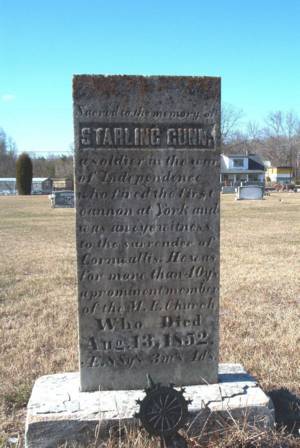
- Born Nottoway County, Virginia
- Revolutionary War Veteran
- Buried Yanceyville Methodist Church
 Click on Photograph for Larger Image
|
|
Starling Gunn was born in Nottoway County, Virginia, in 1764. He moved to Caswell County after the conclusion of the Revolutionary War, but exactly when is not known. An 1835 North Carolina Revolutionary War pension record lists him as a private. The actual pension application apparently had been filed in 1832. Most believe that Gunn settled in Caswell County between 1785 and 1791, when he purchased 400 acres on Rattlesnake Creek. Both his father, Thomas Gunn, and his brother, Griffith Gunn, also moved to Caswell County. Whether they were in the county before Starling is unknown. However, all three are thought to have been established in Caswell County by 1792.
Starling Gunn is buried in the Yanceyville Methodist Church cemetery, and a photograph of his tombstone is shown above. The epitaph on the stone reads as follows:
Sacred to the memory of Starling Gunn a soldier in the war of Independence who fired the first cannon at York and was an eye witness to the surrender of Cornwallis. He was for more than 40 yrs a prominent member of the M. E. Church. Who Died Aug. 13, 1852. AE. 88 y's 3 m's 4d's.A newspaper obituary stated that he "assisted in placing and firing the first gun upon the British at Yorktown." Starling Gunn would have been just age seventeen when he performed these deeds. Before his remains were moved to the Yanceyville Methodist Church cemetery in 1950, he had been buried some 1.5 miles north in a family cemetery.
Note the following from the declaration that he made in 1832 in support of his Revolutionary War pension application:
[In 1781] [t]his Declarant was marched to old Jamestown under the aforesaid named officer. From thence we marched to Williamsburg and there remained some time. And from there we followed in pursuit of the enemy to Yorktown where we besieged the enemy. At this place this declarant was (by an arrangement of the officers) taken out of the Infantry (into which he had volunteered at Williamsburg) and was put in the Artillery and assisted in digging the trenches and building the fort and assisted in firing the first Gun that he recollects to have been fired upon the Enemy.
. . . .
. . . This Declarant was well acquainted with a great many regular officers who were with the troops where he served. He knew Col.Lamb, Col. Price, Genl. Mecklenburg, Genl. Wayne, Genl. LayFayette and Genl. Washington.Starling Gunn was active in Caswell County politics and was a staunch supporter of the Methodist Church. Note the following from William Powell's Caswell County History (at 440):
Itinerant ministers were welcomed in homes along the way and they often stayed for extended periods of time when they found a warm welcome and an attentive congregation. It was recalled at a later time that Revolutionary veteran Starling Gunn reserved a special room in his modest home as the "Preacher's Room." It was described as being comfortably furnished and often used. Tradition relates that it was Gunn who constructed a building that came to be known as Piney Grove Methodist Church. From hewn logs he and his neighbors erected a 40 by 24-foot building for the use of any minister who passed; a partition three feet high across the back of the building marked off an area reserved for any slaves who wished to attend.According to family records, Starling Gunn married Mary Hooper (1768-1843) on October 5, 1785. They had thirteen children. Mary Hooper Gunn is buried alongside her husband in the Yanceyville Methodist Church cemetery.